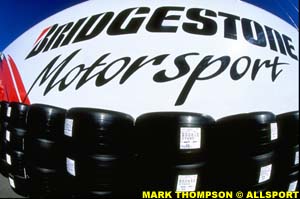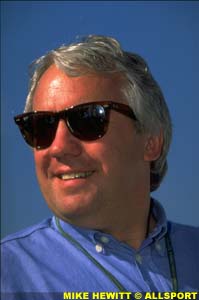| ATLAS F1 Volume 6, Issue 33 | |||
 |
The F1 Rulebook | ||
| by Will Gray, England | |||
|
In a series of articles, Will Gray delves into Formula One's rulebook and investigates the in-depth documentation that governs F1: from rules defining how the event should be run, to those restricting designers and engineers in technical areas
Fifth Part: The Checkers
Scrutineers promote fair competition. To ensure the racing teams play ball, this team spends every hour of every race weekend checking and re-checking the F1 machines. The Grand Prix weekend begins on the Thursday before the race itself, with initial scrutineering in the garages. From then until the end of the weekend, the scrutineers can call any car into the scrutineering bay (which is usually situated in a garage at one end of the pitlane) at any point. The scrutineers can demand to look at any part or sample they require, and can even ask a team to dismantle a car for them to check. Also, if a car which has already passed by the scrutineers is dismantled in any way which may affect its safety or eligibility, they can call it back in and check it over once again - the teams really are at the mercy of the scrutineers!
Furthermore, if a car stops on the circuit, the driver must return to the pits, often accompanied by a supervising marshall, and go straight to the weighing area, to ensure he was not underweight when he was out on the circuit. This can prove a major annoyance in a tight qualifying session, and waiting to be weighed can cost a driver places on the grid. Both car and driver must also be weighed after the race, with every finisher required in the scrutineering bay - but if a driver has to leave his car (for instance to get to the podium) he can be weighed individually, as is often seen in the coverage at the end of a Grand Prix.
Tyres are another important part of racing which demands tight surveillance. Teams can choose from two types of dry tyre, and three specifications of wets, but may use no more than 32 drys and 28 wets in one race weekend. Although drivers are allowed to practice on the two different dry compounds, once qualifying comes, they must nominate one and stick with it for the remainder of the weekend. It is up to the tyre manufacturers to provide tyres to meet the tight regulations for groove depth, tread area, etc. when new, but at the event, the scrutineers have strict control over the tyre usage, and all tyres the team plans to use in the event are marked.
The use of the spare car is another area which is controlled by the FIA scrutineers. In the past, this was limited as less well off teams complained that they couldn't afford to take a spare. Now, the rules are quite free on the subject. In qualifying, a driver can use as many as three cars, so long as they are all of the same make and have been through scrutineering. However, the change of car must be done under the supervision of the marshals, and once the Grand Prix has started, there is no way a driver can jump out of his dying car in a race and hop into a spare.
Teams can communicate between the pits and the car, but the only electronic transmissions allowed are telemetry signals and lap triggers - the rest of the communication must be through pit boards, pit to car radio, and the driver's own body movement. Onboard each car has a data recorder which, like the black box in an aeroplane, stores data in the event of an accident or incident. The data recorder can be recalled to the FIA for checking at any point, and if this is done, a member of the team will be present when the data is downloaded, a copy of the data will be made available to the team, and any conclusions will be published in a report which is agreed between the two parties.
The world of Formula One was recently shown how important the knowledge of the scrutineer is when Charlie Whiting, the FIA Technical Delegate, was considering returning to a team. Opposers to his move claimed his knowledge of all the Grand Prix cars was so great he would give any team an unfair advantage. Now, a rule states that no car can run a component that has been designed, supplied or constructed by a member of the FIA previously involved in checking F1 electronic systems in the past two years. This prevents such a move, but the incident proved that the skills of the scrutineer must be as honed as those of the designers.
Previous Parts in this Series: Part 1 | Part 2 | Part 3 | Part 4
|
| Will Gray | © 2000 Kaizar.Com, Incorporated. |
| Send comments to: gray@atlasf1.com | Terms & Conditions |
Scrutineering bay image provided by LAT | |
 This team is also responsible for checking the weight of the cars, and unless there are reasonable circumstances, they will exclude a car immediately if it is underweight. The FIA has a special drive-on weighbridge which travels around with the Grand Prix circus, and is positioned in the scrutineering bay. The cars to be weighed will be selected at random, and after seeing the red light at the pit entrance, the car must go directly to the weighing area, where the car and driver will be weighed together. To prevent any team adding items to increase the car's weight, it must not be touched by anyone other than the officials, and no-one other than they are allowed into the weighing area.
This team is also responsible for checking the weight of the cars, and unless there are reasonable circumstances, they will exclude a car immediately if it is underweight. The FIA has a special drive-on weighbridge which travels around with the Grand Prix circus, and is positioned in the scrutineering bay. The cars to be weighed will be selected at random, and after seeing the red light at the pit entrance, the car must go directly to the weighing area, where the car and driver will be weighed together. To prevent any team adding items to increase the car's weight, it must not be touched by anyone other than the officials, and no-one other than they are allowed into the weighing area.

